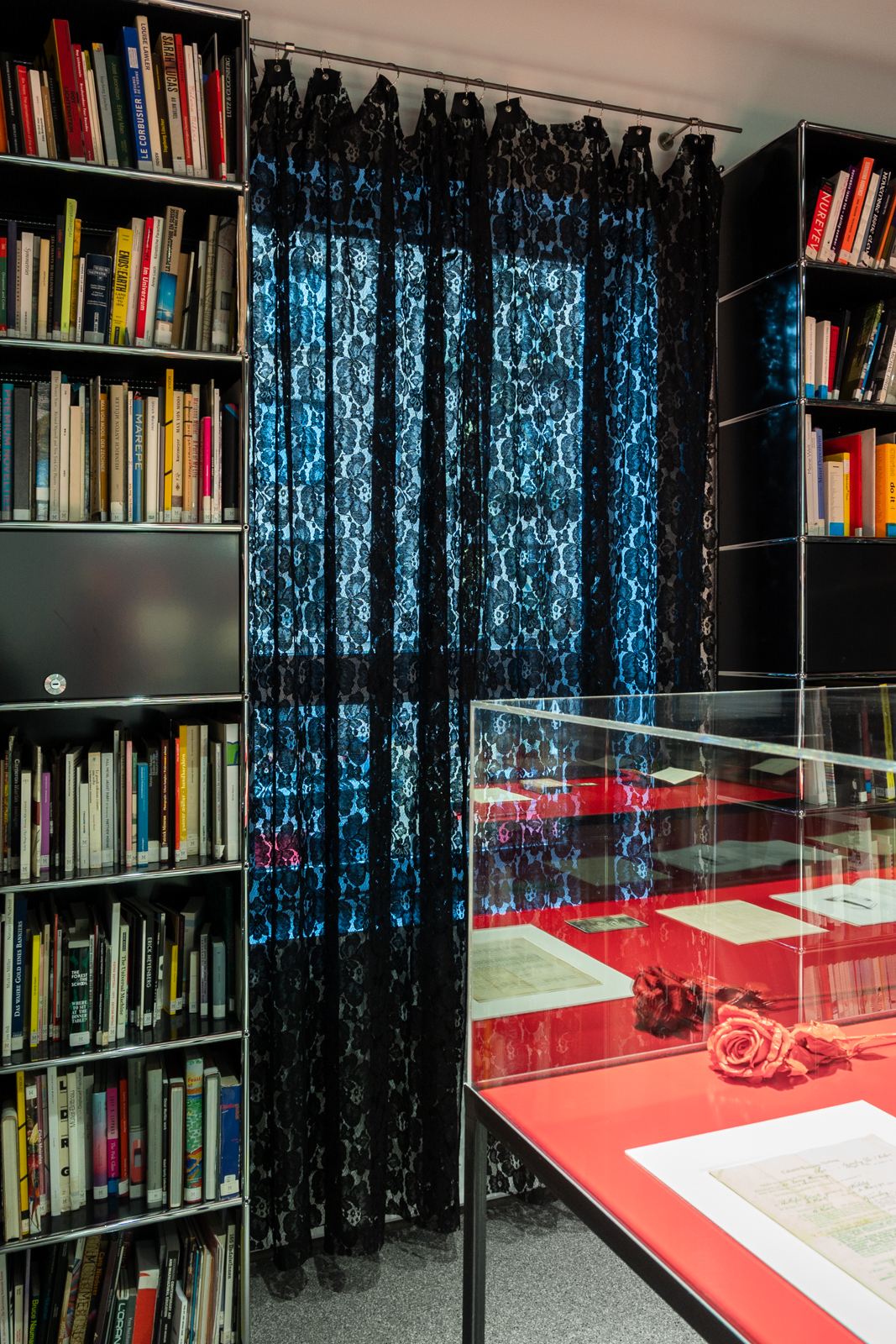Emmy Hennings / Sitara Abuzar Ghaznawi | Mousse
Oct 05 2021

Roses are red, and received notions of aesthetic value are boring to Sitara Abuzar Ghaznawi. The flower is a recurring motif in her work, which most often takes the form of mixed-media installations. Artificial stems abound—the kind you might find in a craft store, dipped in red or black or silver paint or left bare. They are mounted to bolts of cloth or stapled to assemblages consisting of wooden trays, garbage bin liners, pleated vinyl, black lace, smoothed-out aluminum foil, bubble wrap, and pieces cut from those boxy nylon “Chinatown” or “migrant worker” plaid bags that get sent up by luxury fashion brands every few years.
In Episode 4 (The Embarrassment) (2021) the flowers are hung with a trio of used cigarette butts and metallic-pink block-heeled boots against an expanse of red latex. Viewed sequentially, the subtitles of this series sketch out a pithy narrative of class consciousness: Episode 1 (Acting Elite), Episode 2 (Spiritual Growth), Episode 3 (Anger Management), Episode 4 (The Embarrassment), Episode 5 (Permanent Force). In another body of work that responds to the forgotten legacy of writer and Cabaret Voltaire cofounder Emmy Hemmings, a stylized bloom is repeated to become a large-scale, handsomely retro print. Extending the fetish-but-make-it-syndicalist palette, this floral pattern is printed onto black cotton fabric used as the backdrop of vitrine installations like Showcase (Flower 1) (2020) and cast in black lace in Leila (2020). The latter was hung in the window above the entrance of Swiss Institute, New York, for her show Emmy Hennings / Sitara Abuzar Ghaznawi (2020), and seen from outside, the curtains suggested nothing so much as the chiaroscuro of mashrabiya or jaali latticework.
In Ghaznawi’s numbered Pillar and Sculpture series (2020), the same fake roses are tucked into heavy chains suspended from the ceiling, or among angled steel rods interwoven with fabric scraps, diamante strips, sateen, gingham or animal print ribbons, ball chains, and various faux-gilt jewelry that some might see as lowbrow or tacky. Some 2021 iterations of these ropelike works bear the title Family Intervention and the name of a female friend or family member. A pair of collages upon burned dress shirts, Male Extinction 1 and Male Extinction 2 (both 2021), further hint at a world depopulated of presumably cis men (why not?), while the series entitled Vulgar Collages (2019–ongoing) makes overt the artist’s interest in material hierarchies.
Ghaznawi’s deployment of mass-produced petro-textiles and cheap haberdashery is as precise as it is evocative. She makes no attempt to upcycle or otherwise smooth over her materials’ humble origins. Rather, their mobilization in institutional contexts highlights just how constructed, classist—and by extension racialized—are normative Western notions of good taste. In this, the works serve as bulwarks against the pervasive post-Enlightenment tendency to erase difference—the linguistic and cultural practices of recent immigrants, for example—through homogenization and assimilation. Contra the impulse to read a non-Western artist through their background—and in some artists’ cases, to perform alterity or a marginalized identity—Ghaznawi is purposefully spare in her provision of biographical details. She was born in Ghazni, a small city in southeastern Afghanistan, and now lives and works in Zurich. Commissioned texts that accompany her exhibitions are similarly opaque, eschewing explanation or context in favor of aphoristic poetry or quasi-manifestos containing lines like: “You wanna spend the nights with me or only with the idea of me? You think my black hair comes as decoration?”Or: “We have no time for your crocodile tears. Not for any Karen and also not for any extension of a Karen. Bye.”1
But the artist’s upbringing nevertheless quietly speaks in her choice of materials, which are drawn from her lived experience. Western European aesthetics are equally present in the framing and armatures of works like Bookshelf 2 (empty, fragile) (2020), in which empty aluminum shelves bisect roses-and-lace-printed wallpaper. Instead of opening on this visual regime’s obsolescence, the work’s caption devastatingly denotes the medium with the single word “dust.” At Swiss Institute her vitrines evinced an interest in museological aesthetics and the institutional construction of power, particularly through exhibition architecture and industrial design.
The same concerns thrummed through her (rather funerary) first institutional solo show, Underworld Classic at Luma Westbau, Zurich (2019). All tables and chairs in the café space were replaced with an austere platform-cum-seating for the small collages hung around the room. At the installation’s center, silvery roses seemed to grow out of a swirly, galactic reflective surface, and the overall effect was one of flowers pushing out from a grave, or coldly impassive sculptural commemorations of massacres, genocides, terrorist attacks, and the like—the kinds that build state power even as they elide state responsibility.
“The rose is a symbolic figure so rich in meanings that by now it has hardly any meaning left,” Umberto Eco once wrote in reference to his debut novel, The Name of the Rose (1980).2 And indeed, in the West, roses have a surfeit of connotations: feuding English aristocrats, Dante’s visions of heaven, medieval esoteric movements, socialism, and the ? emojied Twitter bios of American DSA bros, love and passion or whatever. Ghaznawi’s roses invoke an entirely different semiotic ecology, for instance the recurring images of the rose and the nightingale symbolizing divine love in Sufism and its associated poetic and lyric traditions. I’m reminded above all of the digitally bedazzled animated gifs of roses with cursive greetings that arrive as a barrage of WhatsApp forwards, tattoos that cover up love turned sour, and those free roses handed to unsuspecting tourists in so many European cities—which are never really free.
by Rahel Aima
